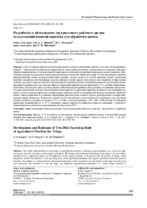Разработка и обоснование двухдискового рабочего органа сельскохозяйственной машины для обработки почвы

Date
2021Publisher
Another Title
Development and Rationale of Two-Disk Operating Body of Agricultural Machine for Tillage
Bibliographic entry
Иванов, А. С. Разработка и обоснование двухдискового рабочего органа сельскохозяйственной машины для обработки почвы = Development and Rationale of Two-Disk Operating Body of Agricultural Machine for Tillage / А. С. Иванов, М. С. Пузырев, Е. М. Чикишев // Наука и техника. – 2021. – № 5. – С. 383-389.
Abstract
Одна из главных проблем при проектировании сельскохозяйственных машин, в том числе почвообрабатывающих, – обеспечение оптимальной энергоемкости выполнения различных технологических операций. Конструктивные, кинематические и технологические параметры ротационных почвообрабатывающих машин оказывают существенное влияние на показатели энергоемкости процесса и качество обработки почвы. К этим параметрам относятся диаметр рабочего органа сельскохозяйственной машины, угловая скорость и частота вращения дисков, количество режущих элементов, поступательная скорость рабочего органа, высота образуемого при обработке почвы гребня, толщина срезаемой стружки. Важной агротехнической характеристикой почвообрабатывающей ротационной машины является гребнистость дна борозды. Высота образуемых гребней должна быть менее 20 % глубины обрабатываемой почвы. В настоящее время для обеспечения требуемой высоты гребней в конструкциях ротационных машин имеется ряд ограничений, которые обусловливают режим работы и параметры агрегатов. В процессе исследований оценивали степень влияния параметров разработанного рабочего органа и затрачиваемой энергии на качество обработки почвы. Опыты проводили на установке, включавшей рабочий орган, силовой агрегат, регулирующую и контрольно-измерительную аппаратуру. В качестве силовой части использовали электродвигатели переменного тока с фазовым ротором, мощность которых составляла 0,75 и 1,50 кВт, а частота вращения – 920, 1500 и 3000 об/мин. Установлены параметры, позволяющие на 11–17 % уменьшить затраты энергии на обработку почвы по сравнению с существующими машинами и обеспечить выравнивание дна борозды до 80 %.
Abstract in another language
One of the main problems in the design of agricultural machines, including tillage machines, is to ensure the optimal energy intensity of various technological operations. The design, kinematic and technological parameters of rotary tillage machines have a significant impact on the indicators of the energy intensity of the process and the quality of tillage. These parameters include the diameter of the operating body of the agricultural machine, the angular speed and rotational speed of the disks, the number of cutting elements, the translational speed of the operating body, the height of the ridge formed during soil cultivation, the thickness of the cut chips. An important agrotechnical parameter of a rotary tillage machine is the ridging of the furrow bottom. The height of the ridges formed should not be less than 20 % of the depth of the cultivated soil. Currently, in order to ensure the required height of the ridges in the designs of rotary machines, there are a number of restrictions that determine the operating mode and parameters of the units. The degree of influence of the parameters of the developed operating body and the energy consumption on the quality of tillage has been assessed in the process of the research. The experiments have been carried out on an installation that included an operating body, a power unit, control and instrumentation equipment. As the power section, AC motors with a phase rotor were used, the power of which was 0.75 and 1.50 kW, and the speed of rotation was 920, 1500 and 3000 rpm. The parameters have been set that allow to reduce the energy consumption for tillage by 11–17 %, compared to existing machines, and ensure the alignment of the furrow bottom by up to 80 %.
View/
Collections
- № 5[12]
